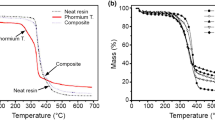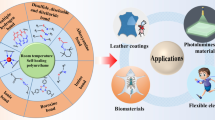Abstract
Novel green biodegradable thermoplastic natural rubber (GB-TPNR) based on natural rubber and polyester blends was prepared by dynamic vulcanization. The main objective was to improve mechanical and rheological properties, thermal stability and biodegradability of the natural rubber/polyester thermoplastic vulcanizates (TPVs). Three types of natural rubber: unmodified NR, and epoxidized natural rubbers with 25 and 50 mol % epoxide (i.e., ENR-25 and ENR-50); and two polyester types: polybutylene succinate (PBS) and poly(butylene succinate-co-butylene adipate) (PBSA) were used as blend components. It was found that the dynamically cured ENR-50/PBS blends exhibited superior mechanical, rheological, thermal and stress relaxation properties relative to ENR-25/PBS and unmodified NR/PBS TPVs. This is attributed to stronger chemical interactions between the polar functional groups of ENR-50 and PBS, which caused strong interfacial adhesion and hence the smallest vulcanized rubber domains dispersed in the PBS matrix. Furthermore, stress relaxation, thermal resistance, mechanical strength and degree of crystallinity of PBS phase increased with epoxide content in the modified rubber. Moreover, the dynamically blended ENR-50/PBSA showed larger vulcanized rubber domains along with poorer mechanical, relaxation and thermal properties but easier biodegradation than the ENR-50/PBS blend.














Similar content being viewed by others
References
Jibin H, Wenquan C, Shijia Z, Yuan W, Lili H, shuya L, Hongchi T (2020) The research and development of thermoplastic elastomers. SVOA Mat Sci Tech 2(2):34–46
Shanks R, Kong I (2012) In: El-Sonbati AZ (ed) Thermoplastic Elastomers. IntechOpen, London, pp 137–154
Holden G (2011) Thermoplastic elastomers. In: Kutz M (ed) Applied Plastics Engineering Handbook. Elsevier, Amsterdam, pp 91–107
Kalkornsurapranee E, Nakason C, Kummerlöwe C, Vennemann N (2013) Development and preparation of high-performance thermoplastic vulcanizates based on blends of natural rubber and thermoplastic polyurethanes. J Appl Polym Sci 128(4):2358–2367. https://doi.org/10.1002/app.38201
Nakason C, Wannavilai P, Kaesaman A (2006) Thermoplastic vulcanizates based on epoxidized natural rubber/polypropylene blends: Effect of epoxide levels in ENR molecules. J Appl Polym Sci 101(5):3046–3052. https://doi.org/10.1002/app.23926
Mohamad N, Zainol NS, Rahim FF, Maulod HEA, Rahim TA, Shamsuri SR, Azam MA, Yaakub MY, Abdollah MFB, Mohd Manaf MEA (2013) Mechanical and morphological properties of polypropylene/epoxidized natural rubber blends at various mixing ratio. Procedia Eng 68:439–445. https://doi.org/10.1016/j.proeng.2013.12.204
Nakason C, Jarnthong M, Kaesaman A, Kiatkamjornwong S (2008) Thermoplastic elastomers based on epoxidized natural rubber and high-density polyethylene blends: Effect of blend compatibilizers on the mechanical and morphological properties. J Appl Polym Sci 109(4):2694–2702. https://doi.org/10.1002/app.28265
Ahmad I, Fern LP (2006) Effect of PE-g-MA-compatibilizer on the morphology and mechanical properties of 70/30 HDPE/ENR blends. Polym-Plast Tech Eng 45(6):735–739. https://doi.org/10.1080/03602550600611271
Attaran SA (2015) Tensile barrier and degradation properties of low density polyethylene/epoxidized natural rubber nanocomposites films. PhD dissertation, Universiti Teknologi Malaysia
Chuayjujit S, Sakulkijpiboon S, Potiyaraj P (2010) Preparation of thermoplastic elastomer from epoxidised natural rubber and polystyrene. Polym Polym Comp 18:139–144. https://doi.org/10.1177/096739111001800303
Nikolic MS, Djonlagic J (2001) Synthesis and characterization of biodegradable poly(butylene succinate-co-butylene adipate)s. Polym Deg Stab 74(2):263–270. https://doi.org/10.1016/S0141-3910(01)00156-2
Fujimaki T (1998) Processability and properties of aliphatic polyesters, ‘BIONOLLE’, synthesized by polycondensation reaction. Polym Deg Stab 59(1–3):209–214. https://doi.org/10.1016/S0141-3910(97)00220-6
Seggiani M, Altieri R, Cinelli P, Esposito A, Lazzeri A (2021) Thermoplastic blends based on poly(butylene succinate-co-adipate) and different collagen hydrolysates from tanning industry: I—processing and thermo-mechanical properties. J Polym Env. 2021; 29, 392–403. https://doi.org/10.1007/s10924-020-01880-y
Zhang X, Zhang Y (2016) Reinforcement effect of poly(butylene succinate) (PBS)-grafted cellulose nanocrystal on toughened PBS/polylactic acid blends. Carbohyd polym 140:374–382. https://doi.org/10.1016/j.carbpol.2015.12.073
Zhao P, Liu W, Wu Q, Ren J (2010) Preparation, mechanical, and thermal properties of biodegradable polyesters/poly(lactic acid) blends. J Nanomat 287082. https://doi.org/10.1155/2010/287082
de Matos Costa AR, Crocitti A, Hecker de Carvalho LH, Carroccio SC, Cerruti P, Santagata G (2020) Properties of biodegradable films based on poly(butylene succinate) (pbs) and poly(butylene adipate-co-terephthalate) (PBAT) blends. Polymers 12(10):2317. https://doi.org/10.3390/polym12102317
Pang M, Qiao J, Jiao J, Wang S, Xiao M, Meng Y (2008) Miscibility and properties of completely biodegradable blends of poly(propylene carbonate) and poly(butylene succinate). J Appl Polym Sci 107(5):2854–2860. https://doi.org/10.1002/app.27252
Boonprasertpoh A, Pentrakoon D, Junkasem J (2017) Investigating rheological, morphological and mechanical properties of PBS/PBAT blends. J Metal Mat Mine 27(1):1–11
Singsang W, Petprom W, Junphong N, Charerntanom W, Srakaew N, Hasook A, Prasoetsopha N (2022) Effects of natural rubber compound and crumb rubber on mechanical and morphological properties of biodegradable poly(butylene succinate). J Phys Conf Ser 2175:012012
Aliotta L, Vannozzi A, Canesi I, Cinelli P, Coltelli MB, Lazzeri (2021) Poly(lactic acid) (PLA)/poly(butylene succinate-co-adipate) (PBSA) compatibilized binary biobased blends: melt fluidity, morphological, thermo-mechanical and micromechanical analysis. Polymers 13(2):218. https://doi.org/10.3390/polym13020218
Pivsa-Art W, Pavasupree S, O-Charoen N, Insuan U, Jailak P, Pivsa-Art S (2011) Preparation of polymer blends between poly (l-lactic acid), poly (butylene succinate-co-adipate) and poly (butylene adipate-co-terephthalate) for blow film industrial application, Ener Proc. 9:581–588. https://doi.org/10.1016/j.egypro.2011.09.068
Puekpoonpoal N, Phattarateera S, Kerddonfag N, Aht-Ong D (2021) Morphology development of PLAs with different stereo-regularities in ternary blend PBSA/PBS/PLA films. Polym-Plast Tech Mat 60(15):1672–1685. https://doi.org/10.1080/25740881.2021.1930043
Arif ZU, Khalid MY, Sheikh MF, Zolfagharian A, Bodaghi M (2022) Biopolymeric sustainable materials and their emerging applications. J Envi Chem Eng 10(4):108159. https://doi.org/10.1016/j.jece.2022.108159
Tang S, Li J, Wang R, Zhang L, Lu Y, Hu G-H, Wang Z, Liqun Zhang L (2022) Current trends in bio-based elastomer materials. Sus Mat 2:2–33. https://doi.org/10.1002/sus2.45
ISO Standard 6502-3 (2018) Rubber—Measurement of vulcanization characteristics using curemeters — Part, vol 3. Rotorless curemeter
Faibunchan P, Nakaramontri Y, Chueangchayaphan W, Pichaiyut S, Kummerlöwe C, Vennemann N, Nakason C (2018) Novel biodegradable thermoplastic elastomer based on poly(butylene succinate) and epoxidized natural rubber simple blends. J Polym Env 26:2867–2880. https://doi.org/10.1007/s10924-017-1173-4
Grestenberger G, Potter G, Grein C (2014) Polypropylene/ethylene-propylene rubber (PP/EPR) blends for the automotive industry: Basic correlations between EPR-design and shrinkage. Exp Polym Let 8(4):282–292. https://doi.org/10.3144/expresspolymlett.2014.31
ISO Standard 37 (2017) Rubber, vulcanized or thermoplastic —. Determination of tensile stress-strain properties
ISO Standard 7619-1 (2010) Rubber, vulcanized or thermoplastic — Determination of indentation hardness — Part 1: Durometer method (Shore hardness)
Faibunchan P, Pichaiyut S, Chueangchayaphan W, Kummerlöwe C, Venneman N, Nakason C (2019) Influence type of natural rubber on properties of green biodegradable thermoplastic natural rubber based on poly(butylene succinate). Polym Adv Tech 30(4):1010–1026. https://doi.org/10.1002/pat.4534
Pradeep SA, Kharbas H, Turng L-S, Avalos A, Lawrence JG, Pilla S (2017) Investigation of thermal and thermomechanical properties of biodegradable PLA/PBSA composites processed via supercritical fluid-assisted foam injection molding. Polymers 9(1):22. https://doi.org/10.3390/polym9010022
ISO 527-2 (2012) Plastics - Determination of tensile properties — Part 2. Test conditions for moulding and extrusion plastics
Boonkerd K, Deeprasertkul C, Boonsomwong K (2016) Effect of sulfur to accelerator ratio on crosslink structure, reversion, and strength in natural rubber. Rub Chem Techno 89(3):450–464. https://doi.org/10.5254/rct.16.85963
Klinklai W (2005) Preparation and Li + conductivity of highly deproteinized natural rubber having epoxy Group. J Eng RMUTT 5(3):70–75
Johnson T, Thomas S (2000) Effect of epoxidation on the transport behaviour and mechanical properties of natural rubber. Polymer 41(20):7511–7522. https://doi.org/10.1016/S0032-3861(00)00076-8
Faibunchan P, Pichaiyut S, Kummerlöwe, Vennemann N, Nakason C (2020) Green biodegradable thermoplastic natural rubber based on epoxidized natural rubber and poly(butylene succinate) blends: Influence of blend proportions. J Polym Environ 28:1050–1067. https://doi.org/10.1007/s10924-020-01655-5
Puchalski M, Szparaga G, Biela T, Gutowska A, Sztajnowski S, Krucinska I (2018) Molecular and supramolecular changes in polybutylene succinate (PBS) and polybutylene succinate adipate (PBSA) copolymer during degradation in various environmental conditions. Polymers 10(3):251. https://doi.org/10.3390/polym10030251
Wu S, Zhang Y, Han J, Xie Z, Xu J, Guo B (2017) Copolymerization with polyether segments improves the mechanical properties of biodegradable polyesters. ACS Omega 2:2639–2648. https://doi.org/10.1021/acsomega.7b00517
Seggiani M, Altieri R, Cinelli P, Esposito A, Lazzeri A (2021) Thermoplastic blends based on poly(butylene succinate-co-adipate) and different collagen hydrolysates from tanning industry: I—Processing and thermo-mechanical properties. J Polym Environ 29:392–403. https://doi.org/10.1007/s10924-020-01880-y
Sansatsadeekul J, Sakdapipanich J, Rojruthai P (2011) Characterization of associated proteins and phospholipids in natural rubber latex. J Biosc Bioeng 111(6):628–634. https://doi.org/10.1016/j.jbiosc.2011.01.013
Tserki V, Matzinos P, Pavlidou E, Vachliotis D, Panayiotou C (2006) Biodegradable aliphatic polyesters. Part I. Properties and biodegradation of poly(butylene succinate-co-butylene adipate). Polym Deg Stab 91(2):367–376. https://doi.org/10.1016/j.polymdegradstab.2005.04.035
Acknowledgements
This research was financially supported by the Thailand Research Fund (TRF) through the Royal Golden Jubilee Ph.D. Program (Grant no. PHD/0208/2557) to Dr. Charoen Nakason as principal researcher, and to Miss Parisa Faibunchan as the research assistant. Also, the authors would like to express their gratitude to Faculty of Engineering and Computer Science, University of Applied Sciences Osnabrück, Germany, which is gratefully acknowledged for providing access to its facilities. In addition, we would like to thank Dr. Seppo Karrila for his assistance with the manuscript preparation.
Author information
Authors and Affiliations
Corresponding author
Additional information
Publisher’s Note
Springer Nature remains neutral with regard to jurisdictional claims in published maps and institutional affiliations.
Rights and permissions
Springer Nature or its licensor (e.g. a society or other partner) holds exclusive rights to this article under a publishing agreement with the author(s) or other rightsholder(s); author self-archiving of the accepted manuscript version of this article is solely governed by the terms of such publishing agreement and applicable law.
About this article
Cite this article
Pichaiyut, S., Faibunchan, P., Kummerlöwe, C. et al. Investigation of Rheological, Morphological and Mechanical Properties, Thermal Stability, Biodegradability of the Dynamically Cured Natural Rubber/Polyester Blends. J Polym Environ 31, 1051–1070 (2023). https://doi.org/10.1007/s10924-022-02582-3
Accepted:
Published:
Issue Date:
DOI: https://doi.org/10.1007/s10924-022-02582-3




